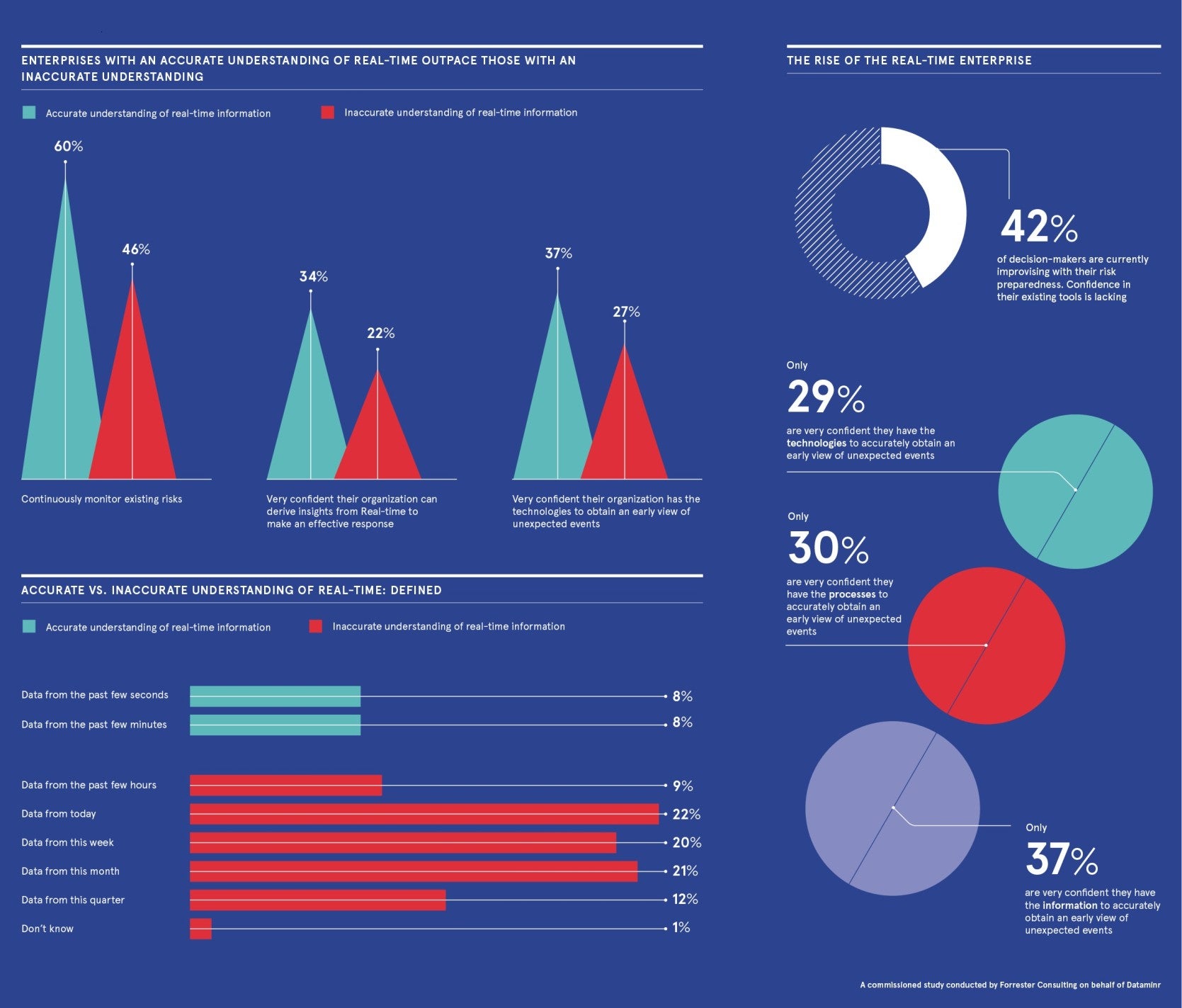Over the past decade, the ways in which we produce and consume information have evolved enormously. The global health and economic impacts of the Covid-19 pandemic have accelerated change further, pushing the boundaries of potential risks to the enterprise.
The breadth of enterprise risks has been expanding for some time now, growing at the rapid speed of digital adoption and technology-fuelled globalisation. For business leaders, this means that a threat to physical locations can come just as easily from a data breach as it can from a local power cut. Or threats to their brand’s reputation can surface on social platforms they aren’t even invested in or aware of, rather than a single in-person customer complaint.
Before Covid-19, the real-world consequences of a poor or slow response to a crisis spanned sharp declines in shareholder value, executive resignations and impacts to brand reputation, customer loyalty, employee retention and more. Then, during the height of the pandemic last year, the ramifications of failing to prepare for the unexpected, and underestimating or overestimating the potential impact across business-critical functions, became painfully clear.
Though endless, enterprise risks can be broadly categorised into four segments: operational, business intelligence, cyber, and reputation and brand management, each with its own subcategories. Operational risk, for instance, includes subcategories of asset protection, executive protection, physical security, travel safety, human health, logistics and deliveries.
Enterprise risks today can be broadly categorised into four segments: operational, business intelligence, cyber, and reputation and brand management, each with their own subcategories
“Real-time information about emerging risks and disruptive events across the key segments of the enterprise is vital for decision-makers.” So says Jason Edelboim, chief operating officer and president at Dataminr, whose AI platform for real-time event and risk detection enables tens of thousands of users at hundreds of organisations to learn first of breaking events worldwide, form effective mitigation strategies and respond confidently as crises unfold.
While most organisations recognise the importance of real-time information in crisis response, not everyone interprets the term in the same way. Dataminr commissioned a Forrester survey of more than 400 professionals in the UK, US, Australia and New Zealand responsible for managing risk and compliance at companies with annual revenues exceeding $500m. When asked to define “real-time”, their answers ranged from seconds to months.
The respondents were divided in their views, with 47% saying that real-time information is data created some time in the past day. Some of these said minutes or seconds. The other 53% said it is data that’s between a week and a quarter old. Breaking that down further, 8% of risk professionals saw real-time information as data from the past few seconds, while 12% thought it referred to data created within the past three months.

It was also clear from the survey that inflexible technologies and siloed processes are a hindrance, making real-time information less accessible when it is most needed. It found that only 43% of enterprise crisis-response teams include the HR department, for example, while only 33% include the corporate communications team.
“At Dataminr, we deliver actionable, real-time information about emerging risks and impactful events as close to when they occur as possible – often within seconds,” Edelboim says. “Every department needs real-time information that’s tailored to its specific needs, sharing the responsibility of risk detection across the enterprise. Unfortunately, functional silos are common.”
He continues: “As modern crisis management is a shared exercise and disruptions can impact every function, it’s vital that all departments have clearly defined areas of responsibility as per the four main segments of risk, and that leaders allow for a rapid, coordinated response during a crisis. A siloed approach in today’s enterprise risk landscape is one of the greatest risks of all.”
In terms of how organisations are approaching risk management and crisis response, the survey found that more than 80% of risk professionals thought that access to real-time information has never been more necessary. Well over 40% said that they were planning to implement, or expand their implementation of, a real-time alerting platform in 2021.
The study also demonstrated that the inconsistent use and understanding of real-time information hinders strategy and action. Eight out of 10 survey respondents agreed that it is important to have access to real-time information that affects their business, even though only 16% accurately defined real-time information as data that’s no more than a few minutes old.
While managing risk is challenging, it doesn’t have to be entirely daunting. With crises diversifying and happening at the speed at which information spreads, the value of real-time information is immeasurable against the weight of not having an early sight of impactful disruptions. Whether it’s a cyber breach or a PR maelstrom, achieving an accurate, holistic picture of the size and scope of a crisis is essential to making better-informed business decisions.
Especially in the case of global enterprises, real-time information about an incident thousands of miles from headquarters could influence a decision affecting operations in several regions. And, for the employees and external stakeholders in the immediate vicinity of a breaking event, a hyper-local view of that event as it unfolds is crucial for frontline decision-makers to be effective.
“During a corporate crisis, every second counts,” Edelboim says. “Relevant, up-to-date information is a crucial input to crisis management. Incorporating real-time information into your business or function’s critical information system closes the gaps between an emerging risk becoming a crisis, and your response to protect your people, assets and, ultimately, your brand.”
He concludes: “Businesses of all sizes and industries benefit greatly from mapping out risk management plans that describe clear roles and responsibilities, and use real-time information as the North Star in the early detection of emerging risks and crises for coordinating a truly unified response.”
For more information, visit dataminr.com
Q&A: Early detection gives companies the edge

Helen Sutton, senior vice-president of EMEA and APAC sales at Dataminr, reveals the crucial role that real-time data is playing in managing the sheer magnitude and breadth of enterprise risk
What have been the main barriers to business resilience over the past year?
“An enterprise’s ability to adapt to the pandemic era has become an indicator of resilience. That said, most businesses’ resiliency strategies have been put to the test in the past year. And most of those challenges were down to not having enough information or not having it at the right time to make critical decisions quickly. Leaders must connect the dots among the growing diversity of risks, vulnerabilities and gaps they have discovered during this turbulent period and equip decision-makers across the enterprise with real-time information to help them solve real business problems in real time.”
How vital is advanced, intelligent technology to managing enterprise risk effectively?
“Having the right architecture is essential. It’s important to assess the gaps in support, skills and the total risk identification and response framework first and then invest in advanced technology that can effectively and efficiently play the roles you need. A baseline responsibility of any function leader is to drive process innovation. Decision-makers who under-utilise technology are slow to innovate and unable to adapt to the rapid growth of the information landscape. They will fail to grow both their function and their business.”
Leaders now must connect the dots among the growing diversity of risks, vulnerabilities and gaps they have discovered during this turbulent period
How can organisations ensure they identify an evolving risk before it’s too late?
“An unexpected event can occur anywhere at any moment, radically affecting people and operations. Organisations need an early and clear line of sight into a developing situation, with additional context, to enhance their decisions as the incident unfolds. Real-time information is crucial for enhancing organisational agility, sustaining business continuity and responding with speed and confidence. This is especially true as public data sources continue to expand and diversify, spanning social media, information sensors, blogs and the deep web.”
How does Dataminr support enterprises in this area?
Think of Dataminr as your first layer of crisis response. Our AI platform processes billions of units of public information daily, searching for early indicators of risk, so you don’t have to do that manual labour and risk missing critical information. The technology provides the first warnings of high-impact events to users across an enterprise to enable more effective risk mitigation strategies and faster coordinated responses.
Dataminr has detected millions of global, national and hyper-local events since its first patent in 2010. Our initial detection of the Covid-19 virus from local Chinese social media platforms such as Weibo, at 9.11am Eastern Standard Time on 30 December 2019. This provided our customers, which include global corporations, public sector agencies, NGOs, and newsrooms, with the earliest warning in advance of the CDC announcement seven days later, and the WHO’s report ten days later.
Can you reveal some companies you’ve worked with and how they use your technology?
We work with hundreds of corporations in dozens of industries, including more than half of the Fortune 50. We have a significant footprint in retail, financial services, technology, telecoms, pharma, insurance, automotive, real estate, transport and logistics. Our value is industry-agnostic and our customer base, which includes Goldman Sachs, Vodafone, L’Oréal, Netflix, Dyson and Shell, reflects that. Our customers rely on Dataminr for real-time alerts to protect their people, brand and physical and virtual assets every day. They’re continually uncovering new use cases in areas such as physical safety and security, reputation risk and crisis management, business intelligence, logistics and cyber threat detection.
What is your vision of the future of enterprise risk?
The future of enterprise risk is expansive. About 95% of the 150,000-plus data sources that integrate into our platform didn’t even exist in 2009. One can imagine that the risks coming at the onset of new social platforms and public data sets in 10 years will differ from today’s ones. The only way to prepare for that is to understand how the information landscape is changing and be able to access the right information at the right time. We’re at the forefront of real-time event detection, but we have only scratched the surface of the potential use cases.
Sponsored by
Over the past decade, the ways in which we produce and consume information have evolved enormously. The global health and economic impacts of the Covid-19 pandemic have accelerated change further, pushing the boundaries of potential risks to the enterprise.
The breadth of enterprise risks has been expanding for some time now, growing at the rapid speed of digital adoption and technology-fuelled globalisation. For business leaders, this means that a threat to physical locations can come just as easily from a data breach as it can from a local power cut. Or threats to their brand’s reputation can surface on social platforms they aren’t even invested in or aware of, rather than a single in-person customer complaint.
Before Covid-19, the real-world consequences of a poor or slow response to a crisis spanned sharp declines in shareholder value, executive resignations and impacts to brand reputation, customer loyalty, employee retention and more. Then, during the height of the pandemic last year, the ramifications of failing to prepare for the unexpected, and underestimating or overestimating the potential impact across business-critical functions, became painfully clear.

